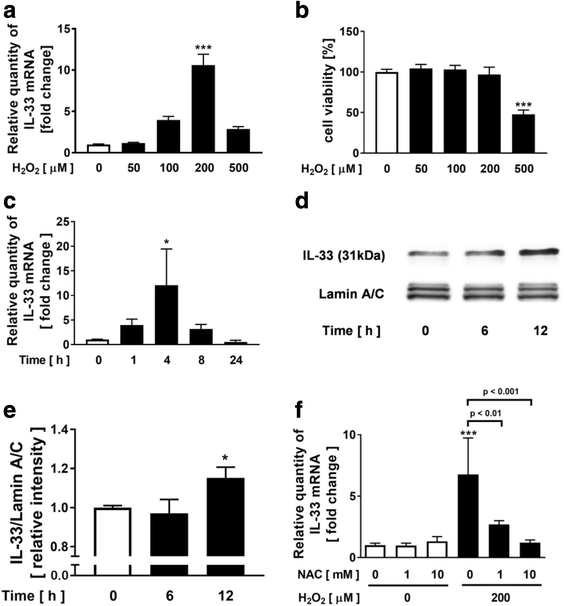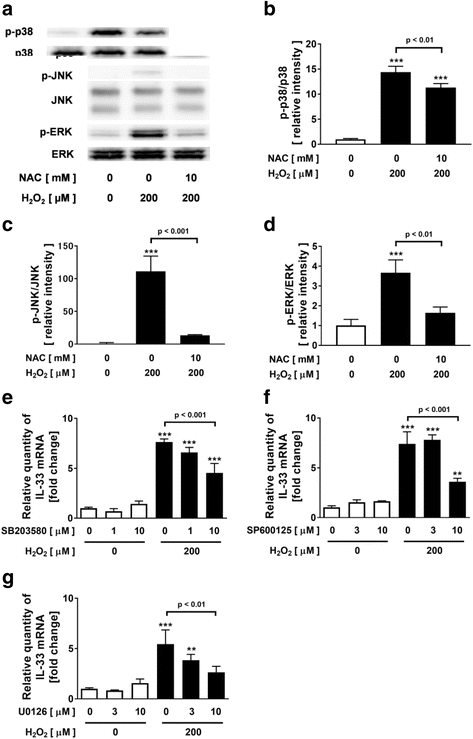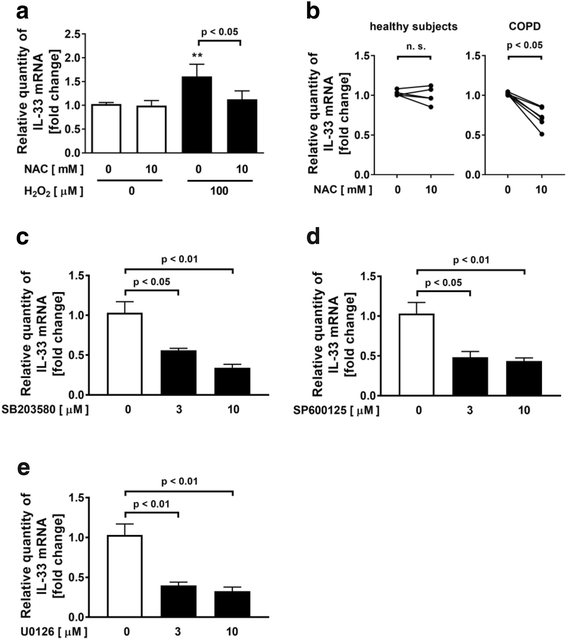Oxidative stress enhances the expression of IL-33 in human airway epithelial cells
- PMID: 29587772
- PMCID: PMC5872512
- DOI: 10.1186/s12931-018-0752-9
Oxidative stress enhances the expression of IL-33 in human airway epithelial cells
Erratum in
-
Correction to: Oxidative stress enhances the expression of IL-33 in human airway epithelial cells.Respir Res. 2018 Jun 12;19(1):116. doi: 10.1186/s12931-018-0817-9. Respir Res. 2018. PMID: 29895305 Free PMC article.
Abstract
Background: Interleukin-33 (IL-33) is a cytokine belonging to the IL-1 family, and its possible involvement in the pathophysiology of COPD and viral-induced exacerbations has been demonstrated. IL-33 has been shown to be increased in the airway epithelial cells from COPD patients, but the regulating mechanism of IL-33 expression in airway epithelial cells remains largely unknown. In the current study, we examined whether oxidative stress, which participates in the pathogenesis of COPD, affects the expression of IL-33 in airway epithelial cells and also evaluated the effect during viral infection.
Methods: The involvement of oxidative stress in the expression of IL-33, and its signal pathway was examined after stimulation with hydrogen peroxide (H2O2), with or without stimulation by polyinosinic-polycytidylic acid [poly (I:C)], a synthetic analogue of dsRNA that mimics viral infection, or rhinovirus infection in NCI-H292 cells and primary human bronchial epithelial cells (HBECs). In addition, the effect of antioxidant, N-acetylcysteine (NAC) in the expression of IL-33 was compared between HBECs from healthy subjects and those from COPD patients.
Results: Treatment with H2O2 significantly potentiated IL-33 expression in NCI-H292 cells, and the potentiation was reversed by NAC treatment. Mitogen-activated protein kinase (MAPK) inhibitors, but not nuclear factor-kappa B inhibitors, also significantly decreased the H2O2-potentiated IL-33 expression. In addition, H2O2 significantly potentiated the poly (I:C)- or rhinovirus-stimulated IL-33 expression. In HBECs from healthy subjects, H2O2-potentiated IL-33 expression and its reversal by NAC was also confirmed. Under the condition without H2O2-stimulation, treatment with NAC significantly decreased the expression of IL-33 in HBECs from COPD patients, but not in those from healthy subjects.
Conclusions: These results demonstrate that oxidative stress involves in the expression of IL-33 in airway epithelial cells via MAPK signal pathway and it augments IL-33 expression during viral infection. This mechanism may participate in the regulation of IL-33 expression in airway epithelial cells in COPD and the viral-induced exacerbations. Modulation of this pathway could become a therapeutic target for viral-induced exacerbations of COPD.
Keywords: COPD; Exacerbation; IL-33; Oxidative stress; Viral infection.
Conflict of interest statement
Ethics approval and consent to participate
All experiments in the study were approved by ethics committee of Tohoku University Graduate School of Medicine and written informed consent was obtained from all participating patients.
Consent for publication
Not applicable.
Competing interests
The authors declare that they have no competing of interests.
Publisher’s Note
Springer Nature remains neutral with regard to jurisdictional claims in published maps and institutional affiliations.
Figures






References
-
- Lozano R, Naghavi M, Foreman K, Lim S, Shibuya K, Aboyans V, et al. Global and regional mortality from 235 causes of death for 20 age groups in 1990 and 2010: a systematic analysis for the global burden of disease study 2010. Lancet. 2012;380:2095–2128. doi: 10.1016/S0140-6736(12)61728-0. - DOI - PMC - PubMed
-
- Kanner RE, Anthonisen NR, Connett JE. Lower respiratory illnesses promote FEV(1) decline in current smokers but not ex-smokers with mild chronic obstructive pulmonary disease: results from the lung health study. Am J Respir Crit Care Med. 2001;164:358–364. doi: 10.1164/ajrccm.164.3.2010017. - DOI - PubMed
-
- Connors AF, Jr, Dawson NV, Thomas C, Harrell FE, Jr, Desbiens N, Fulkerson WJ, et al. Outcomes following acute exacerbation of severe chronic obstructive lung disease. The SUPPORT investigators (study to understand prognoses and preferences for outcomes and risks of treatments) Am J Respir Crit Care Med. 1996;154:959–967. doi: 10.1164/ajrccm.154.4.8887592. - DOI - PubMed
Publication types
MeSH terms
Substances
LinkOut - more resources
Full Text Sources
Other Literature Sources

